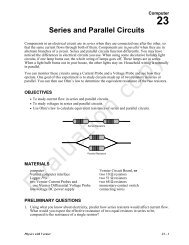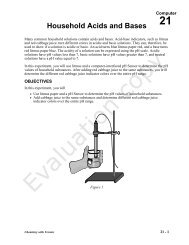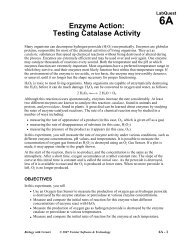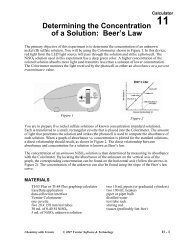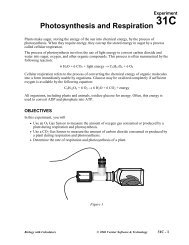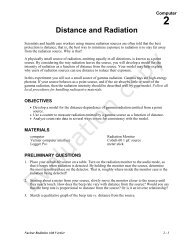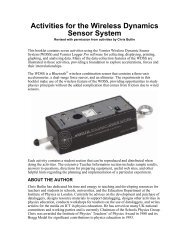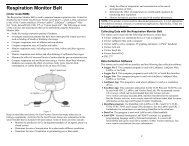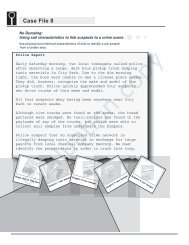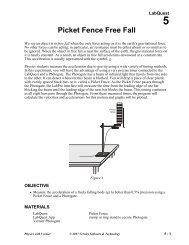Photosynthesis
Photosynthesis
Photosynthesis
You also want an ePaper? Increase the reach of your titles
YUMPU automatically turns print PDFs into web optimized ePapers that Google loves.
<strong>Photosynthesis</strong>Experiment7The process of photosynthesis involves the use of light energy to convert carbon dioxide andwater into sugar, oxygen, and other organic compounds. This process is often summarized bythe following reaction:6 H 2 O + 6 CO 2 + light energy ←→ ⎯ C 6 H 12 O 6 + 6 O 2This process is an extremely complex one, occurring in two stages. The first stage, called thelight reactions of photosynthesis, requires light energy. The products of the light reactions arethen used to produce glucose from carbon dioxide and water. Because the reactions in thesecond stage do not require the direct use of light energy, they are called the dark reactions ofphotosynthesis.In the light reactions, electrons derived from water are “excited” (raised to higher energy levels)in several steps, called photosystems I and II. In both steps, chlorophyll absorbs light energy thatis used to excite the electrons. Normally, these electrons are passed to a cytochrome containingan electron transport chain. In the first photosystem, these electrons are used to generate ATP. Inthe second photosystem, excited electrons are used to produce the reduced coenzymenicotinamide adenine dinucleotide phosphate (NADPH). Both ATP and NADPH are then usedin the dark reactions to produce glucose.In this experiment, a blue dye (2,6-dichlorophenol-indophenol, or DPIP) will be used to replaceNADPH in the light reactions. When the dye is oxidized, it is blue. When reduced, however, itturns colorless. Since DPIP replaces NADPH in the light reactions, it will turn from blue tocolorless when reduced during photosynthesis. This will allow you to monitor the rate ofphotosynthesis. In order to allow the DPIP to come into contact with chloroplasts, the cells willneed to be carefully disrupted. You will test for photosynthetic activity in blended spinachleaves. The intensity of color, measured as absorbance, will be detected by a Colorimeter.OBJECTIVESIn this experiment, you will• Use a Colorimeter to measure color changes due to photosynthesis.• Study the effect of light on photosynthesis.• Study the effect that the boiling of plant cells has on photosynthesis.• Compare the rates of photosynthesis for plants in different light conditionsFigure 1Biology with Handhelds 7 - 1
Experiment 7MATERIALSLabPro interfacePalm handheld250 mL beakertwo small test tubesData Pro programVernier Colorimeter5 mL pipettwo eyedroppers or Beral pipetstwo cuvettes with lids 10 mL DPIP/phosphate buffer solutionaluminum foil covered cuvette with lid unboiled chloroplast suspension100 watt floodlight boiled chloroplast suspensionwatch or clock with second hand ice600 mL beakerPROCEDURE1. Obtain and wear goggles.2. Obtain two plastic Beral pipets, two cuvettes with lids, and one aluminum foil coveredcuvette with a lid. Mark one Beral pipet with a U (unboiled) and one with a B (boiled). Markthe lid for the cuvette with aluminum foil with a D (dark). For the remaining two cuvettes,mark one lid with a U (unboiled) and one with a B (boiled).3. Plug the Colorimeter into Channel 1 of the LabPro interface. Connect the handheld to theLabPro using the interface cable. Firmly press in the cable ends.4. Press the power button on the handheld to turn it on. To start Data Pro, tap the Data Pro iconon the Applications screen. Choose New from the Data Pro menu or tap to reset theprogram.5. Prepare a blank by filling an empty cuvette ¾ full with distilled water. Seal the cuvette witha lid. To correctly use a Colorimeter cuvette, remember:• All cuvettes should be wiped clean and dry on the outside with a tissue.• Handle cuvettes only by the top edge of the ribbed sides.• All solutions should be free of bubbles.• Always position the cuvette with its reference mark facing toward the white referencemark at the right of the cuvette slot on the Colorimeter.6. Set up the handheld and interface for the Colorimeter.a. Place the blank in the cuvette slot of the Colorimeter and close the lid.b. If the handheld displays ABSORBANCE in CH 1, press the < or > button on theColorimeter to select a wavelength of 635 nm (Red). Then calibrate by pressing the CALbutton on the Colorimeter and proceed directly to Step 7. If the handheld does not displayABSORBANCE in CH 1, continue with this step to set up your sensor manually.c. On the Main screen, tap .d. On the Setup screen, tap , then choose COLORIMETER from the list of sensors.e. Tap , then tap .7 - 2 Biology with Handhelds
<strong>Photosynthesis</strong>Calibrate the Colorimeter.f. Open the Colorimeter lid.g. Holding the cuvette by the upper edges, place it in the cuvette slot of the Colorimeter.Close the lid.First Calibration Pointh. Turn the wavelength knob of the Colorimeter to the 0% T position. In the Value fieldenter “0” as the percent transmittance. You can enter this information using the onscreenkeyboard (tap “123”), or by using the Graffiti writing area. When the voltage readingstabilizes, tap .Second Calibration Pointi. Turn the wavelength knob of the Colorimeter to the Red LED position (635 nm). Enter“100” as the percent transmittance. When the voltage reading stabilizes, tap .j. Click three times to return to the Main screen.7. Obtain a 600 mL beaker filled with water and a floodlamp. Arrange the lamp and beaker as shown inFigure 2. The beaker will act as a heat shield,protecting the chloroplasts from warming by theflood lamp. Do not turn the lamp on until Step 11.8. Locate the unboiled and boiled chloroplast suspensionprepared by your instructor. Before removing any ofFigure 2the chloroplast suspension, gently swirl to resuspendany chloroplast which may have settled out. Using the pipet marked U, draw up ~1 mL ofunboiled chloroplast suspension. Using the pipet marked B, draw up ~1 mL of boiledchloroplast suspension. Set both pipettes in the small beaker filled with ice at your labstation to keep the chloroplasts cooled.9. Add 2.5 mL of DPIP/phosphate buffer solution to each of the cuvettes. Important: performthe following steps as quickly as possible and proceed directly to Step 10.a. Cuvette U: Add 3 drops of unboiled chloroplasts. Place the lid on the cuvette and gentlymix; try not to introduce bubbles in the solution. Place the cuvette in front of the lamp asshown in Figure 2. Mark the cuvette’s position so that it can always be placed back in thesame spot.b. Cuvette D: Add 3 drops of unboiled chloroplasts. Place the lid on the cuvette and gentlymix; try not to introduce bubbles in the solution. Place the foil-covered cuvette in front ofthe lamp as shown in Figure 2 and mark its position. Make sure that no light canpenetrate the cuvette.c. Cuvette B: Add 3 drops of boiled chloroplasts. Place the lid on the cuvette and gentlymix; try not to introduce bubbles in the solution. Place the cuvette in front of the lamp asshown in Figure 2. Mark the cuvette’s position so it can always be returned to the samespot.10. Take absorbance readings for each cuvette. Invert each cuvette two times to resuspend thechloroplast before taking a reading. If any air bubbles form, gently tap on the cuvette lid toknock them loose.a. Cuvette U: Place the cuvette in the cuvette slot of the Colorimeter and close the lid. Allow10 seconds for the readings displayed on the handheld screen to stabilize, then record theabsorbance value in Table 1. Remove the cuvette and place it in its original position infront of the lamp.Biology with Handhelds 7 - 3
Experiment 7b. Cuvette D: Remove the cuvette from the foil sleeve and place it in the cuvette slot of theColorimeter. Close the Colorimeter lid and wait 10 seconds. Record the absorbance valuedisplayed on the handheld screen in Table 1. Remove the cuvette and place it back intothe foil sleeve. Place the cuvette in its original position in front of the lamp.c. Cuvette B: Place the cuvette in the cuvette slot of the Colorimeter and close the lid. Allow10 seconds for the readings displayed on the handheld screen to stabilize, then record theabsorbance value in Table 1. Remove the cuvette and place it in its original position infront of the lamp.11. Turn on the lamp.12. Repeat Step 10 when 5 minutes have elapsed.13. Repeat Step 10 when 10 minutes have elapsed.14. Repeat Step 10 when 15 minutes have elapsed.15. Repeat Step 10 when 20 minutes have elapsed.DATATable 1 Table 2Time(min)AbsorbanceunboiledAbsorbancein darkAbsorbanceboiledChloroplastRate ofphotosynthesis0 Unboiled5 Dark10 Boiled1520PROCESSING THE DATACalculate the rate of photosynthesis for each of the three cuvettes tested by performing a linearregression on each of the data sets.1. Prepare the handheld for data entry.a. On the Main screen, tap .b. Tap , then choose Manual Entry.c. Enter the X Input Label (Time) and unit (min). You can enter this information using theonscreen keyboard (tap “abc”), or by using the Graffiti writing area.d. Enter the Y Input Label (Absorb) and unit (none).e. Tap . A data table will be displayed on the screen.2. Enter the absorbance and time data pairs from the Unboiled column of Table 1.a. In the first value field, enter “0” for the initial time at which data was taken. You canenter this value using the numerical keyboard displayed on the screen.7 - 4 Biology with Handhelds
<strong>Photosynthesis</strong>b. Tap .c. Enter the initial absorbance value from the Unboiled column of Table 1.d. Tap .e. Continue to enter the data pairs using the same process until you have entered the 5 timeand absorbance data pairs for the Unboiled chloroplasts.f. When the data for the Unboiled column have been entered, tap , then tap toview a graph of absorbance vs. time.3. Perform a linear regression to calculate the rate of photosynthetic activity.a. Tap , then tap .b. From the Fit Equation menu, choose Linear. The linear-regression statistics for these twodata columns are displayed for the equation in the formy = ax + bwhere x is concentration, y is absorbance, a is the slope, and b is the y-intercept.c. Enter the absolute value of the slope, a, as the rate of photosynthetic activity in Table 2.d. Tap twice to return to the Graph screen.4. On the Graph screen, tap and then repeat Steps 2 - 3 of Processing the Data for theDark and Boiled data.QUESTIONS1. Is there evidence that spinach chloroplasts were able to reduce DPIP in this experiment?Explain.2. Were chloroplasts able to reduce DPIP while kept in the dark? Explain.3. Were boiled chloroplasts able to reduce DPIP? Explain.4. What conclusions can you make about the photosynthetic activity of spinach?EXTENSION - PLANT PIGMENT CHROMATOGRAPHYPaper chromatography is a technique used to separate substances in a mixture based on themovement of the different substances up a piece of paper by capillary action. Pigments extractedfrom plant cells contain a variety of molecules, such as chlorophylls, beta carotene, andxanthophyll, that can be separated using paper chromatography. A small sample of plantpigment placed on chromatography paper travels up the paper due to capillary action. Betacarotene is carried the furthest because it is highly soluble in the solvent and because it forms nohydrogen bonds with the chromatography paper fibers. Xanthophyll contains oxygen and doesnot travel quite as far with the solvent because it is less soluble than beta carotene and formssome hydrogen bonds with the paper. Chlorophylls are bound more tightly to the paper than theother two, so they travel the shortest distance.The ratio of the distance moved by a pigment to the distance moved by the solvent is a constant,R f . Each type of molecule has its own R f value.R f =distance traveled by pigmentdistance traveled by solventBiology with Handhelds 7 - 5
Experiment 7OBJECTIVESIn this experiment, you will• Separate plant pigments.• Calculate the R f values of the pigments.MATERIALS50 mL graduated cylinder cork stopperchromatography paperpencilspinach leavesscissorscoinsolventgogglesrulerPROCEDUREObtain and wear goggles! Caution: The solvent in this experiment is flammable and poisonous.Be sure there are no open flames in the lab during this experiment. Avoid inhaling fumes. Weargoggles at all times. Notify your teacher immediately if an accident occurs.1. Obtain a 50 mL graduated cylinder with 5 mL of solvent in the bottom.2. Cut the chromatography paper so that it is long enough to reach the solvent. Cut one end ofthe paper into a point.3. Draw a pencil line 2.0 cm above the pointed end of the paper.4. Use the coin to extract the pigments from the spinach leaf. Place a small section of the leafon top of the pencil line. Use the ribbed edge of the coin to push the plant cells into thechromatography paper. Repeat the procedure 10 times making sure to use a different part ofthe leaf each time.5. Place the chromatography paper in the cylinder so the pointed end just touches the solvent.Make sure the pigment is not in the solvent.6. Stopper the cylinder and wait until the solvent is approximately 1 cm from the top of thepaper. Remove the chromatography paper and mark the solvent front before it evaporates.7. Allow the paper to dry. Mark the bottom of each pigment band. Measure the distance eachpigment moved from the starting line to the bottom of the pigment band. Record the distancethat each of the pigments and the solvent moved, in millimeters.8. Identify each of the bands and label them on the chromatography paper.• beta carotene:• xanthophyll:• chlorophyll a:• chlorophyll b:yellow to yellow orangeyellowbright green to blue greenyellow green to olive green9. Staple the chromatogram to the front of your lab sheet.7 - 6 Biology with Handhelds
<strong>Photosynthesis</strong>10. Discard the solvent as directed by your teacher.DATATable 1Band numberDistance traveled(mm)Band colorIdentity12345*Distance solvent front moved =mm* The fifth band may not appear.PROCESSING THE DATACalculate the R f values and record in Table 2.Table 2MoleculeR fbeta carotenexanthophyllchlorophyll achlorophyll bQUESTIONS1. What factors are involved in the separation of the pigments?2. Would you expect the R f value to be different with a different solvent?3. Why do the pigments become separated during the development of the chromatogram?ADDITIONAL EXTENSIONS1. Repeat the paper chromatography with various species of plants. What similarities do yousee? What differences are there?Biology with Handhelds 7 - 7
Experiment 72. Use colored filters around the cuvettes to test the effect of red, blue, and green light on thephotosynthetic activity of spinach.3. Vary the distance of the floodlight source to determine the effect of light intensity onphotosynthesis.4. Compare the photosynthetic activity of spinach with that of chloroplasts from other plants.5. Investigate the effect of temperature on the photosynthetic activity of spinach.6. Explain why the rate of photosynthesis varies under different environmental conditions.7 - 8 Biology with Handhelds
Experiment7TEACHER INFORMATION<strong>Photosynthesis</strong>1. It is necessary to suspend the spinach chloroplasts in a 0.5 M sucrose solution. To preparethe 0.5 M sucrose solution, add 171 g of sucrose to distilled water to make a total volume of 1liter. Store this solution in the refrigerator overnight before preparing the chloroplast solution.Place the blender and beaker in the freezer overnight also.2. To prepare the phosphate buffer solution:a. Add 174 g of K 2 HPO 4 (dibasic) to distilled water to make a total volume of 1 liter.b. Add 136 g of KH 2 PO 4 (monobasic) to distilled water to make a total volume of 1 liter.c. Combine the two solutions until the pH is 6.5. About 685 mL of monobasic should beadded to 315 mL of dibasic to obtain a solution with a pH of 6.5.3. To prepare the DPIP (2,6-dichlorophenol-indophenol ) solution, add 0.072 g of DPIP todistilled water to make a total volume of 1 liter. Store this solution in a dark bottle andrefrigerate.4. Prepared DPIP and phosphate buffer solution are available from Carolina Biological SupplyCompany. Prepared solutions should be mixed in a 1:1:3 ratio of DPIP solution to phosphatebuffer solution to distilled water.5. Just prior to doing the experiment, prepare the DPIP solution students will use in Step 9of the student procedure. Combine the DPIP solution with phosphate buffer and distilled waterin the following ratio:• 100 mL of 0.1 % DPIP solution• 100 mL phosphate buffer• 300 mL distilled water6. To prepare a chloroplast suspension,a. Place fresh spinach leaves in the light for a few hours. Be sure they remain cool andhydrated.b. Cover the blades of a blender with cold 0.5 M sucrose.c. Pack the spinach leaves into the blender until they are about three centimeters above theblades.d. Blend the spinach with three 10-second bursts. Wait 30 seconds between bursts.e. Filter the mixture through cheesecloth into a cold beaker. Keep the beaker on ice. Youwill need to squeeze the cheesecloth to release as much liquid as possible.f. Split the chloroplast suspension into two equal parts. Set one part aside for Item 7 below.g. Distribute 2-mL portions into covered, cooled vials. The vials should be light-tight. Blackelectrical tape works well to cover the vials.h. Keep the chloroplast suspensions on ice.7. Obtain the spinach solution that was set aside in Item 6 and boil it for 5 minutes. Distribute2-mL portions of boiled chloroplasts into darkened, taped vials. Keep these suspensions on ice.8. Test the chloroplast suspension prior to use. If the DPIP is reduced too rapidly, further diluteBiology with Calculators7 - 1 T
Experiment 7the suspension before distributing it into the vials.9. The success of this lab is greatly dependent on the ability of the students to synchronizetaking absorbance readings. Encourage the students to read over the procedure carefully beforebeginning.10. The procedure used to calibrate at 0% and 100% transmittance is similar to that usedwith most spectrophotometers. The blank cuvette can be in the colorimeter for the 0%calibration (as well as the 100% calibration). This is because the LED is turned off when thewavelength knob is in the 0%T position.11. The cuvette must be from 55% to 100% full in order to get a valid absorbance reading. Ifstudents fill the cuvette 3/4 full, as described in the procedure, they should be in this range.12. Since there is some variation in the amount of light absorbed by the cuvette if it isrotated 180°, you should use a water-proof marker to make a reference mark on the top edge ofone of the clear sides of all cuvettes. Students are reminded in the procedure to align this markwith the reference mark to the right of the cuvette slot on the colorimeter.13. Prepare the solvent for chromatography by mixing 9 parts (by volume) petroleum etherwith 1 part acetone. Distribute 5 mL of solvent to each of the cylinders Warning: Be verycareful with the petroleum ether as it is highly flammable. Extinguish all flames in the room.HAZARD ALERT: Petroleum Ether: Flammable liquid; flammable; dangerous fire risk.Hazard code: C—Somewhat hazardous.HAZARD ALERT: Acetone: Dangerous fire risk; flammable; slightly toxic by ingestionand inhalation. Hazard code: C—Somewhat hazardousThe hazard information reference is: Flinn Scientific, Inc., Chemical & Biological CatalogReference Manual, 2000, P.O. Box 219, Batavia, IL 60510. See Appendix F of this book,Biology with Calculators, for more information.14. Remember to handle paper strips by the edges only15. Remind students to wear goggles and to keep the tubes stoppered16. Refer to the MSDS for proper disposal techniques.7 - 2 T Biology with Calculators
Teacher Information<strong>Photosynthesis</strong>SAMPLE RESULTSTable 1Time(min)UnboiledabsorbanceDarkabsorbanceBoiledabsorbance0 xxxx xxxx xxxx5 xxxx xxxx xxxx10 xxxx xxxx xxxx15 xxxx xxxx xxxx20 xxxx xxxx xxxxTable 2ChloroplastUnboiledDarkBoiledRate ofphotosynthesisxxxxxxxxxxxxANSWERS TO QUESTIONSAnswers have been removed from the online versions of Verniercurriculum material in order to prevent inappropriate student use.Graphs and data tables have also been obscured. Full answers andsample data are available in the print versions of these labs.Biology with Calculators7 - 3 T
Experiment 7EXTENSION SAMPLE RESULTSTable 1Band numberistance traveledmm)Band colorIdentity1 xxxx xxxx xxxx2 xxxx xxxx xxxx3 xxxx xxxx xxxx4 xxxx xxxx xxxx5*Distance solvent front moved = 150 mm* band 5 may not appearTable 2MoleculeR fbeta carotenexanthophyllchlorophyll achlorophyll bxxxxxxxxxxxxxxxxANSWERS TO EXTENSION QUESTIONS7 - 4 T Biology with Calculators




